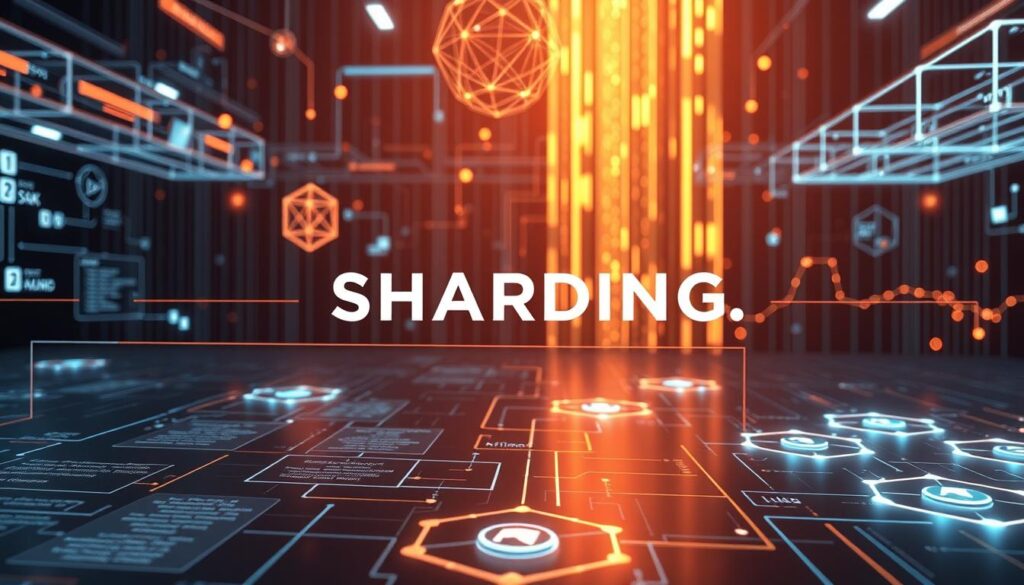Now Reading: Understanding Blockchain Sharding Technology Explained Simply
- 01
Understanding Blockchain Sharding Technology Explained Simply
Understanding Blockchain Sharding Technology Explained Simply

Many digital networks today face serious growth limitations. As more people join these systems, the infrastructure struggles to keep up with demand. This creates bottlenecks that slow down operations and limit potential expansion.
Current distributed ledger systems process only a handful of transactions each second. Bitcoin handles about 7 transactions per second, while Ethereum manages 15-30. Traditional payment processors like Visa can process thousands of transactions in the same timeframe.
This performance gap highlights the urgent need for innovative scaling solutions. The approach called sharding offers a promising path forward. It represents a fundamental shift in how these networks can be structured for better efficiency.
Sharding works by dividing a single network into smaller, more manageable segments. Each segment operates independently but remains connected to the whole system. This allows multiple transactions to be processed simultaneously rather than one after another.
The potential impact is significant. When fully implemented, this method could enable networks to handle over 100,000 transactions every second. This level of performance could support mainstream adoption across various industries.
Key Takeaways
- Current distributed networks process far fewer transactions than traditional payment systems
- Sharding divides networks into smaller segments for parallel processing
- This approach addresses critical scalability limitations
- Potential throughput could reach 100,000+ transactions per second
- The method maintains security while improving performance
- It represents a fundamental architectural shift for network design
- Successful implementation could enable mass adoption across industries
Introduction to Blockchain Sharding
For decentralized networks to achieve global adoption, they must first overcome significant performance hurdles. The core issue lies in how these systems are traditionally built. Every participant, or node, must process and store the entire history of activity.
Understanding the Need for Scalability
This design creates a major bottleneck. As more users join and the volume of transactions grows, the system slows down. Confirmation times increase, and fees can rise sharply during busy periods.
This scalability problem is a fundamental barrier. It makes everyday use, like buying coffee, impractical. Current systems simply cannot match the speed and low cost of centralized alternatives like Visa.
Overview of Blockchain Network Challenges
There is also a growing resource burden. The hardware needed to run a full node becomes more expensive over time. This can lead to centralization, as only large entities can afford to participate fully.
Network architects face a difficult balance. Improving transaction speed often risks weakening security or decentralization. This is known as the “trilemma.” New solutions are needed to enhance scalability without these trade-offs.
Sharding blockchain approaches this by rethinking data organization. It aims for horizontal scaling, allowing the network to grow in capacity as demand increases.
What is Blockchain Sharding Technology Explained Simply?
To grasp how this method works, picture a large library where every visitor must read every single book. This is how traditional networks operate. It creates an immense bottleneck as the library grows.
Simple definition of sharding
Sharding solves this by splitting the massive library into smaller, specialized sections. Each section, called a shard, holds a unique part of the collection. The entire library remains complete when all sections are combined.
This concept isn’t new. It comes from database management, where dividing large datasets boosts performance. Applying it to digital ledgers is a natural evolution for scaling.

How sharding partitions blockchain networks
In a partitioned system, the main network is divided into multiple parallel chains. Each shard processes its own transactions and stores its own data independently.
Nodes are assigned to specific shards. They only handle the workload for their assigned segment. This distribution is the key to dramatically increased throughput.
Shards can be organized by transaction type, geographic region, or other characteristics. Despite operating separately, they communicate to maintain the network’s overall security and unity.
The Mechanics of Shard Chains
Shard chains operate through a carefully designed mechanism that divides computational workload across multiple parallel segments. This architecture enables simultaneous processing of transactions while maintaining system integrity.
Shard creation and structure
The network partitions into independent shard chains, each with dedicated validator committees. These groups of nodes handle specific transaction subsets within their assigned segment.
Every shard maintains its own queue and state data. This allows parallel processing without constant coordination between segments. The structure balances load efficiently across the entire system.

Cross-shard communication protocols
Specialized protocols enable data exchange between different shards. A coordination layer manages these interactions, ensuring security and consistency.
When transactions involve multiple shards, validation requires approval from all relevant committees. This prevents issues like double-spending while maintaining the network’s unified state.
The coordination layer continuously monitors all chains, verifying block validity. It serves as the central authority that binds the entire network together securely.
Core Concepts and Consensus Mechanisms
The security and efficiency of a partitioned network hinge on how validators are assigned and how consensus is reached within each segment. These core concepts ensure the system remains robust while processing transactions in parallel.
Node roles and assignment strategies
In these advanced systems, individual nodes are not responsible for the entire network’s workload. Instead, they are assigned to specific segments. This specialization is key to scaling.
A critical security measure involves randomly assigning validators to different segments. This strategy, used by networks like Ethereum 2.0, prevents any single group from gaining too much influence. Periodic reassignment further enhances protection.
Consensus and validator dynamics
Each segment can employ its own consensus mechanism. This allows for flexibility. Some might use Proof of Stake, while others prefer Byzantine Fault Tolerance algorithms for speed and security.
This setup changes validator dynamics significantly. They only process a fraction of the total data, reducing hardware needs. This supports greater decentralization by allowing more participants.
A two-tier consensus structure emerges. Local agreement within a segment is coordinated with a global layer. This ensures the entire network maintains a unified and secure state.
blockchain sharding technology explained simply
Putting sharding into practice requires a clear, step-by-step plan. This process transforms a single, congested ledger into a high-performance network of parallel chains.
The goal is to boost capacity while keeping the system secure and decentralized.
Step-by-Step Sharding Implementation Guide
The first step is creating a central coordination layer. This beacon chain manages the entire system’s security and consensus.
Next, the main network is split into smaller, independent segments called shards. Each shard processes its own set of transactions and stores its own data.
Validator nodes are then randomly assigned to these segments. This random assignment is a key security feature, preventing any group from controlling a single shard.

Sophisticated protocols are implemented for cross-shard communication. They ensure that transactions involving multiple segments are processed securely.
Finally, mechanisms like fraud proofs guarantee data consistency across all segments. This completes the implementation of a robust sharding blockchain.
Real-World Examples and Use Cases
Several major crypto projects have successfully deployed this method. They serve as powerful examples of its real-world use.
Ethereum’s planned upgrade will introduce 64 shard chains. This aims to dramatically increase its capacity for transactions.
NEAR Protocol uses a dynamic system. It automatically adjusts the number of segments based on network demand.
Polkadot’s architecture uses parallel chains, similar to shards, connected to a central relay chain. This is another successful implementation.
An emerging approach combines this technology with Layer 2 solutions like rollups. Rollups handle complex data off-chain, while sharding enables parallel processing. You can learn more about this evolving sharding and how it helps blockchain.
| Project | Approach | Key Feature | Target Throughput |
|---|---|---|---|
| Ethereum 2.0 | Beacon Chain + 64 Shards | Phased Rollout | 100,000+ TPS |
| NEAR Protocol | Dynamic Sharding | Auto-Scaling Segments | High Scalability |
| Polkadot | Parachain Architecture | Interoperability Focus | Parallel Processing |
Benefits of Sharding for Blockchain Scalability
The architectural shift toward parallel processing brings measurable benefits in both speed and accessibility. This approach fundamentally transforms how distributed systems handle growing demands.
Enhanced transaction speed and throughput
Partitioned networks achieve remarkable improvements in transaction processing capacity. Each segment handles its own queue independently.
This parallel approach eliminates sequential bottlenecks. Systems can process thousands of transactions per second instead of just dozens.

Reduced hardware and resource requirements
Individual nodes only store data from their assigned segment. This dramatically cuts storage needs and hardware costs.
Participants can operate nodes on consumer-grade equipment. This democratizes network participation and enhances decentralization.
| System Type | Transactions Per Second | Node Storage Requirements | Participation Accessibility |
|---|---|---|---|
| Traditional Network | 15-30 TPS | Full chain history | High-end servers needed |
| Sharded Implementation | 100,000+ TPS | Segment data only | Consumer hardware sufficient |
Challenges and Security Risks in Sharded Networks
Security becomes more complex when a system is broken into parallel chains, presenting challenges that demand robust solutions. The division of a network into smaller segments creates unique vulnerabilities that architects must address.
Security vulnerabilities and Sybil attacks
Each individual segment has fewer validators protecting it. This reduced number makes single segments more vulnerable to attacks.
Malicious actors can target specific parts of the network. They might attempt to gain control over a single segment rather than the entire system.
Sybil attacks pose a particular threat. Attackers create multiple identities to gain disproportionate influence within a specific segment.
Data consistency and cross-shard complexities
Independent operation of segments creates data consistency challenges. Different parts might record conflicting information.
Cross-segment communication introduces additional complexity. Transactions involving multiple segments require sophisticated validation protocols.
The coordination layer itself represents a potential single point of failure. Compromising this central component could affect all segments simultaneously.
| Risk Type | Potential Impact | Mitigation Approach |
|---|---|---|
| Segment Takeover | Control of individual network parts | Random validator assignment |
| Data Inconsistency | Conflicting records across segments | Fraud proofs and verification |
| Cross-Segment Attacks | Exploitation during communication | Sophisticated validation protocols |
| Coordination Layer Failure | System-wide disruption | Robust security measures |
The Future of Sharding in Blockchain Innovation
The evolution of distributed ledger systems hinges on their ability to process transactions at a scale comparable to traditional financial networks. This next phase of development focuses on making these systems ready for global use. Scalability solutions are the key to unlocking this potential.
Prospects for Mass Adoption
Widespread use in finance and other industries depends on solving current speed limits. When networks can handle thousands of transactions per second, everyday applications become practical. This level of performance is the gateway to true decentralization and mainstream acceptance.
Innovations on Ethereum and Beyond
Ethereum’s planned upgrade, known as “The Surge,” is a major step forward. It aims to introduce a beacon chain coordinating 64 parallel chains. The goal is a massive increase in capacity.
Other networks are also pushing boundaries. NEAR Protocol uses a dynamic system that adjusts automatically. Polkadot’s architecture offers another successful model for parallel processing.
Hybrid approaches are emerging as the cutting edge. Combining this method with Layer 2 rollups creates a powerful synergy. Rollups manage complex data, while parallel chains handle volume.
| Network | Core Innovation | Key Advantage |
|---|---|---|
| Ethereum (The Surge) | Beacon Chain with 64 Shards | Phased upgrade for high security |
| NEAR Protocol | Dynamic Sharding | Auto-scales based on real-time demand |
| Polkadot | Parachain Architecture | Strong focus on interoperability |
| Hybrid (Sharding + Rollups) | Combined Layer 1 and Layer 2 | Addresses both data and throughput |
The future of this technology is bright, with multiple paths being explored. These innovations promise to transform how digital networks operate. They pave the way for a new era of efficient and accessible systems.
Conclusion
Looking ahead, the successful implementation of advanced scaling methods will determine the practical viability of next-generation ledger systems. The partitioning approach discussed throughout this guide offers a powerful solution to fundamental performance limitations.
Sharding delivers significant advantages, including dramatically increased transaction throughput and reduced hardware demands. However, security considerations and cross-segment communication complexities require sophisticated solutions. The future likely involves combining multiple scaling technology approaches.
As major blockchain networks advance their sharding plans, the crypto ecosystem gains valuable real-world data. For users and developers, understanding these scalability solutions is essential for choosing platforms that can support global applications.
The continued development across various blockchains demonstrates strong confidence in distributed processing as the path toward achieving the scalability needed for mainstream adoption.
FAQ
What is the main problem that sharding solves?
The main problem is scalability. As more users join a network like Ethereum, the entire system can slow down because every node must process every transaction. This creates a bottleneck. Sharding tackles this by splitting the network into smaller, parallel pieces called shards, allowing transactions to be processed simultaneously.
How does sharding actually work in simple terms?
Imagine a large library where one librarian handles every single book request. It gets slow. Sharding is like hiring multiple librarians and dividing the books alphabetically. Each librarian manages their own section. In a crypto network, the entire data is partitioned into shards, with different validators responsible for each part, speeding up transaction processing significantly.
What are the key security risks associated with sharded networks?
A primary risk is that a single shard could be compromised if a malicious actor concentrates enough power on it, known as a single-shard takeover attack. Ensuring secure cross-shard communication is also a challenge, as transactions spanning multiple shards must be coordinated without errors or vulnerabilities.
How does sharding benefit the average user?
Users experience faster transaction times and lower fees. By increasing the network’s capacity, sharding reduces congestion. This makes using decentralized applications (dApps) smoother and more affordable, paving the way for mass adoption without sacrificing decentralization.
Is Ethereum the only blockchain implementing sharding?
A> No, while Ethereum’s upgrade with its beacon chain is a prominent example, other networks like Zilliqa and Near Protocol have already implemented their own versions of sharding. Each project uses slightly different methods to achieve scalability while maintaining security.
What is the difference between sharding and layer-2 solutions like rollups?
Sharding is a layer-1 scaling solution, meaning it changes the fundamental base layer of the network. Rollups, like Optimistic and ZK-rollups, are layer-2 solutions that process transactions off-chain and then post compressed data back to the main chain. They are complementary strategies often used together for maximum scalability.














